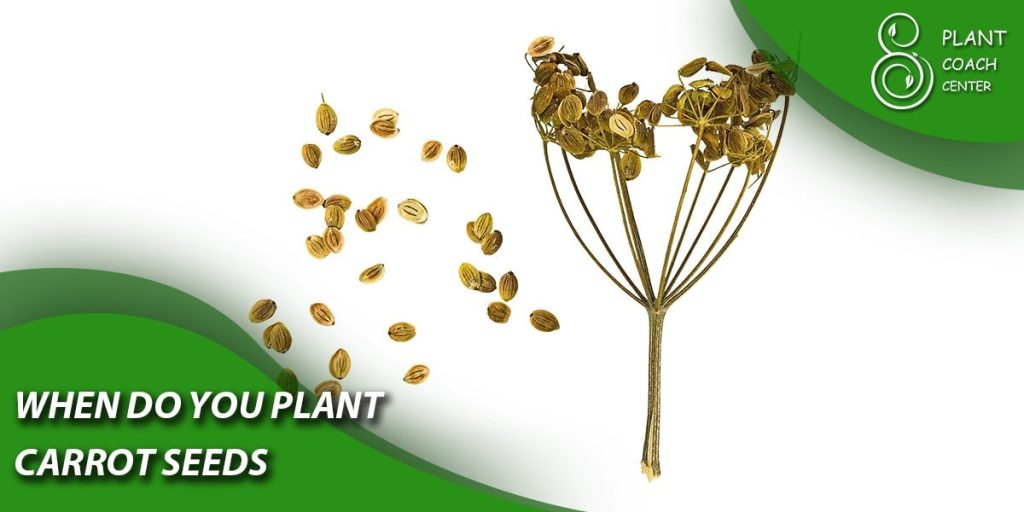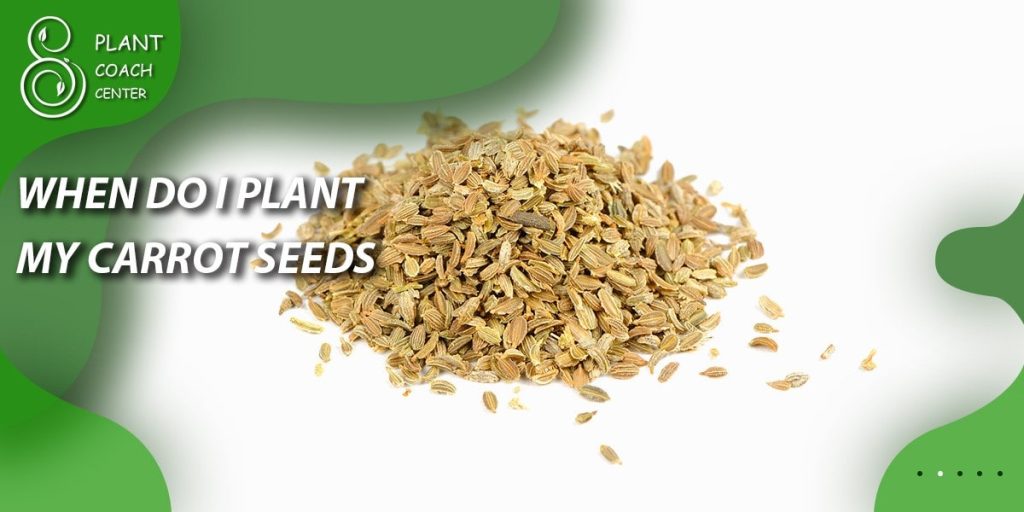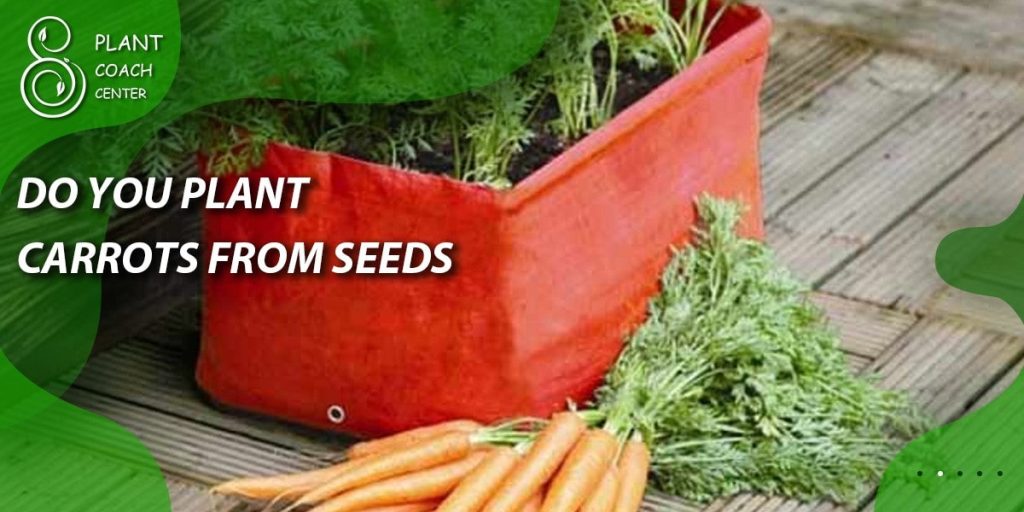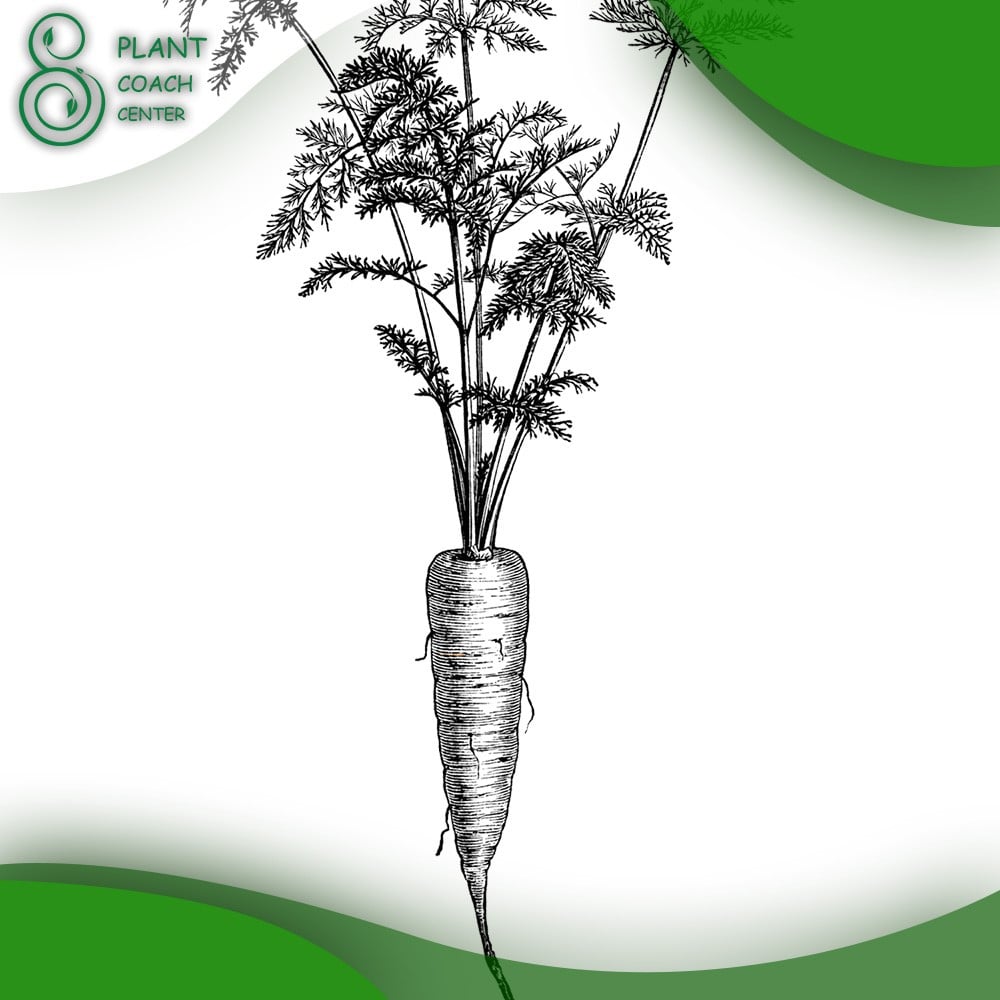When Do You Plant Carrot Seeds?
Welcome to the world of carrot cultivation, where timing is Everything! If you’ve ever wandered into the enchanting realm of gardening, you’ll understand that a bountiful harvest starts with sowing seeds at just the right moment. Carrots, those vibrant and nutritious root vegetables loved by gardeners and food enthusiasts alike, have their own set of preferred conditions when it comes to planting.

Knowing when to sow these crunchy delights can make all the difference between a lackluster yield and a flourishing carrot patch that delights your taste buds and brings a sense of accomplishment. Join us on a captivating journey as we delve deep into the question that every gardener asks When do you plant carrots? Unraveling the secrets to perfect sowing time will empower you to understand the intricacies of nature’s rhythm, interpret the language of the soil and even draw inspiration from the moon and stars to ensure your carrot seeds sprout into a thriving, delectable harvest. So, grab your gardening gloves, and let’s get ready to plant with precision and purpose!
Nature’s Calendar Decoding the Perfect Season for Planting Carrots
As any seasoned gardener will tell you, Mother Nature is essential to successful carrot cultivation. Understanding the nuances of the changing seasons is crucial in determining the perfect time to sow carrot seeds. So, let’s journey through nature’s calendar and discover the optimal season for planting carrots.
Springtime Splendor Spring is a season of renewal, and for many gardeners, it’s the ideal time to plant carrots. As the last frost recedes and the soil starts to warm up, usually around late March or early April, the conditions become favorable for carrot seeds to germinate. The moderate temperatures and increased daylight trigger the seeds’ growth, and you can witness those tender green sprouts peeking through the soil within a couple of weeks.
Summer Adventures While spring is traditionally the primary carrot planting season, certain climates and regions also allow summer planting. In cooler summer climates, you can sow a second batch of carrots around late spring to ensure a continuous harvest throughout the year. However, in hot climates, take precautions to shield the young seedlings from scorching heat and ensure they receive enough water to thrive.
Fall Planting Prospects As summer gradually fades away, the allure of fall gardening beckons. Around late summer or early fall, typically from August to September, you can sow carrot seeds for a late-season crop. The cooling temperatures help prevent the carrots from becoming woody and enhance their flavor. With fewer pests, fall planting offers a more relaxed and enjoyable gardening experience.
Winter Preparations In regions with mild winters, where the ground doesn’t freeze solid, you can experiment with overwintering carrot varieties. Sow the seeds in late summer or early fall, and with some protective mulching, the carrots will hibernate underground, ready to be harvested throughout the winter months.
Watch Out for Frost Carrots are hardy, but young seedlings can be sensitive to frost. If you’re planting early in the spring or late in the fall, keep an eye on the weather forecast and be prepared to provide protection like row covers or clothes if temperatures plummet unexpectedly.
Know Your Zone Understanding your USDA hardiness zone is vital for accurate planting timing. Each site has unique climate characteristics, impacting the optimal planting window for carrots. Check your zone’s last frost date in the spring and first frost date in the fall to plan your carrot planting accordingly.
Reading the Signs Unveiling Soil Temperature and Texture for Planting Carrots
In gardening, understanding the language of the soil is as vital as knowing the changing seasons. Regarding planting carrots, two critical factors come into play soil temperature and texture. Let’s delve into the world beneath our feet and unveil the secrets of reading these signs to determine the perfect time to plant carrots.

Cracking the Soil Temperature Code Soil temperature is a crucial aspect that directly influences seed germination. Carrot seeds are particular about their preferred soil temperature, and planting too early or late can lead to disappointing results. Carrots thrive in soil with a temperature range of 50°F to 85°F (10°C to 30°C). The seeds may stay dormant if the ground is too cold, leading to slow or uneven germination.
On the other hand, planting in hot soil can cause poor seed viability and hinder proper growth. Invest in a soil thermometer to gauge the temperature before planting, ensuring it falls within the carrot’s ideal range.
The Texture Tango Soil texture plays a significant role in determining how well carrots develop underground. Carrots prefer loose, well-draining soil that allows their roots to grow long and straight. Heavy, compacted soils can impede root growth and lead to misshapen or stunted carrots. Before planting, assess your soil’s texture by performing a simple squeeze test.
Grab a handful of moist soil and squeeze it gently. If the ground holds its shape and feels sticky, it may contain too much clay, and amending it with organic matter like compost or sand will help improve drainage. If the soil crumbles apart and doesn’t hold its shape, it may be sandy, which can benefit from added organic matter to retain moisture.
Timing is Everything Combining the knowledge of soil temperature and texture with the changing seasons is essential to find the perfect window for planting carrots. In colder climates, waiting until the soil has warmed up to around 50°F (10°C) before sowing carrot seeds is best. As spring approaches and the ground thaws, the soil temperature becomes favorable for the seeds to germinate and establish strong roots.
Raised Beds and Containers If you’re facing challenges with your native soil, consider using raised beds or containers for carrot cultivation. These allow better control over soil temperature and texture, ensuring an optimal environment for growing carrots. Fill these beds with a loose, well-draining soil mix, and you’ll have a happy home for your carrot seeds.
A Note on Microclimates Keep in mind that different areas within your garden may have microclimates, where factors like sun exposure, wind, and nearby structures can influence soil temperature. Observe these microclimates to choose the best spot for planting your carrots.
Astro-Gardening Harnessing Lunar Cycles for Carrot Planting Success
For centuries, farmers and gardeners have observed the celestial dance of the moon and stars, believing that these heavenly bodies hold sway over the natural world. In gardening, this ancient practice is known as Astro-gardening, where lunar cycles are believed to influence plant growth and yield.
When it comes to planting carrots, enthusiasts of Astro-gardening swear by aligning their gardening activities with the moon’s phases for better results. Explore this mystical realm and discover how harnessing lunar cycles can lead to carrot-planting success.
The Phases of the Moon The lunar cycle consists of four primary phases New Moon, First Quarter, Full Moon, and Last Quarter. Each step is thought to have unique effects on plant growth. During the New Moon, when the moon is barely visible, it’s considered an optimal time for sowing seeds. This phase is believed to enhance root growth, making it an ideal moment to plant carrot seeds, which rely on robust root development.
Sowing with the Waxing Moon The waxing moon period, from New Moon to Full Moon, is believed to promote vigorous growth and above-ground solid development. As the moon’s illumination increases, so does the energy available to plants. Sowing carrot seeds during this phase encourages lush foliage and leafy growth, contributing to long-term healthier carrots.
Rooting with the Waning Moon The waning moon phase, from Full Moon to New Moon, is associated with drawing energy downward. This phase is believed to encourage robust root growth and is considered an excellent time for transplanting and root crops. For carrots, planting during the waning moon can lead to well-established, robust root systems, contributing to the formation of plump, sweet, and flavorful carrots.

Considering Moon-Related Factors Astro-gardening involves more than just sowing seeds based on lunar phases. Moon’s position in the zodiac signs is also considered, with sure symptoms associated with specific plant parts. For root crops like carrots, the moon in earth signs, such as Taurus and Virgo, is considered particularly favorable, as these signs are believed to enhance root growth.
Balancing Tradition and Science While astro-gardening may seem mystical, some scientific studies have explored the relationship between lunar cycles and plant growth. While the results are mixed, some research suggests that lunar forces might have subtle impacts on plants, although more conclusive evidence is needed.
Experimenting with Intuition Whether you’re a skeptic or an enthusiast, exploring astro-gardening for carrot planting can be exciting. Even if you don’t fully embrace the mystical aspects, aligning your gardening activities with the moon’s phases can be a helpful reminder to plant with intention and observe the natural rhythms of the world around you.
The Art of Companion Planting Carrots’ Secret Allies
In the intricate gardening world, companion planting has long been revered as a time-honored practice that harnesses the power of plant partnerships for mutual benefits. When cultivating carrots, savvy gardeners have discovered that sure plant allies can enhance their growth, deter pests, and improve overall yield. Let’s unveil the secrets of companion planting and explore the perfect time to sow carrots alongside their secret allies.
Choosing the Right Companions Companion planting involves strategically pairing plants that have complementary traits or provide mutual support. For carrots, some of their best companions include
- Onions and Garlic These pungent alliums are excellent companions for carrots. They help repel pests like carrot flies, which can otherwise wreak havoc on your carrot crop. Planting onions or garlic near your carrots can create a natural barrier against these unwanted invaders.
- Leafy Greens Plants like lettuce, spinach, and kale can be beneficial neighbors for carrots. Their luscious foliage provides shade to the soil, helping retain moisture and preventing the ground from drying out too quickly. They don’t compete heavily for nutrients, making them compatible planting partners.
- Chives Chives not only deter pests but also improve the flavor of carrots when grown nearby. Chives are believed to enhance the aromatic compounds in carrots, leading to a more flavorful harvest.
- Rosemary and Sage These aromatic herbs are known to repel various pests, including carrot flies, making them valuable companions for carrots. Plus, their delightful fragrance can add a sensory delight to your garden.
Timing is Key. When do you plant carrots with their secret allies? The key is to consider their growth rates and spatial requirements. Carrots are slow growers, and their seeds can take some time to germinate. To avoid crowding, it’s best to sow the carrot seeds first, leaving enough space for their companions to be planted later.

Carrots in the City Urban Gardening Timeframes
City dwellers and urban gardening enthusiasts may need more support. They still can’t experience the joy of growing their own vegetables, including the beloved carrot. With creativity and strategic planning, urban gardening can thrive, providing a fresh and rewarding experience. So, when do you plant carrots in the city, and how can you make the most of your limited space? Let’s explore the optimal timeframes and urban gardening techniques to grow carrots in the concrete jungle.
- Year-Round Gardening One of the advantages of urban gardening is the ability to grow crops year-round, even in areas with milder climates. Carrots can be grown in spring and fall, and with careful planning, you can extend your harvest season by staggering plantings. Consider using containers or raised beds to make the most of limited space and to facilitate crop rotation.
- Early Spring Planting As the last frost recedes in early spring, urban gardeners can seize the opportunity to plant their carrots. Be mindful of your local climate and soil temperature, as carrots prefer more excellent conditions for germination. If you’re dealing with limited space, opt for varieties suited for small containers or vertical gardens.
- Late Summer Planting Urban gardening in the late summer also offers a second chance to plant carrots. As the days start to cool down, planting carrots in late summer allows you to enjoy a fresh harvest during the fall season. Ensure your containers or garden beds receive enough sunlight to encourage healthy growth.
- Indoor Carrots For those with limited outdoor space, indoor gardening can be a fantastic solution. Consider growing carrots in large pots or deep containers near sunny windowsills. Choose shorter varieties better suited for container gardening, and ensure they receive at least 4-6 hours of sunlight daily.
- Vertical Gardening Utilize vertical space to maximize your urban garden. Vertical planters, wall-mounted pots, or hanging baskets can grow carrots in tight spaces. Use well-draining soil and support the developing carrots to prevent them from bending or breaking.
- Community Gardens If you lack sufficient space at home, consider joining a community garden in your area. These shared spaces allow you to cultivate your favorite vegetables, including carrots, while fostering community among fellow urban gardeners.
Overcoming Seasonal Constraints Extending the Carrot Planting Window
For passionate gardeners, seasonal limitations often hinder the desire to grow fresh carrots year-round. With ingenuity and clever gardening techniques, extending the carrot planting window and enjoying a continuous harvest throughout the year is possible. Let’s explore some effective strategies for overcoming seasonal constraints and keeping your carrot patch productive, no matter the time of year. When do you plant carrots to achieve this? Let’s find out.
- Successive Planting is a valuable technique that involves sowing carrot seeds at regular intervals to ensure a steady supply of fresh carrots. Instead of planting all your carrot seeds immediately, stagger the sowings every few weeks. This way, you can harvest mature carrots while younger ones continue to grow, extending the availability of carrots in your garden.
- Utilize Season Extenders, such as row covers, cold frames, and cloches, which are ingenious tools that shield your carrots from harsh weather conditions. By providing extra protection and maintaining a more favorable microclimate around your carrot plants, these devices allow you to start planting carrots earlier in the spring and continue growing them later into the fall.
- Choose Appropriate Varieties. Opt for carrot varieties that are specifically bred for extended growing seasons. Some varieties are more tolerant of colder temperatures, while others are born for their ability to mature quickly. Research and select varieties that align with your desired planting and harvesting schedule.

- Indoor Gardening For ultimate control over your carrot planting window, consider indoor gardening methods. Growing carrots in containers or raised beds indoors, using grow lights if necessary, allows you to bypass seasonal limitations entirely and enjoy fresh carrots year-round. Be mindful of the containers’ depth to accommodate the carrot roots.
- Winter Mulching In regions with mild winters, you can use mulching techniques to protect your carrots from freezing temperatures. Applying a thick layer of mulch around the carrot plants helps insulate the soil, preventing it from freezing solid and allowing your carrots to grow slowly throughout the winter.
- Greenhouse Gardening A greenhouse is a gardener’s dream for extending the growing season. With the controlled environment of a greenhouse, you can create the perfect conditions for planting carrots, regardless of the outside weather. This allows you to sow and harvest carrots year-round, granting you a continuous supply of this delightful root vegetable.
Observation and Adaptation Throughout your journey of extending the carrot planting window, remember to closely observe your plants and the local climate. Adapt your techniques based on how well your carrots respond to different approaches. Gardening is dynamic, and learning from your experiences is critical to success.
Conclusion
In conclusion, mastering the art of planting carrots goes beyond knowing when to sow the seeds. By exploring nature’s calendar, soil temperature, lunar cycles, companion planting, urban gardening, and ingenious techniques to extend the planting window, we have unraveled the secrets to successful carrot cultivation. Embracing these diverse approaches ensures a bravest and deepens our andon with the natural world and the joys of gardening.
As you embark on your carrot-growing journey, visit plantcouchcenter.com for a wealth of resources, tips, and inspiration to enrich your gardening experience. Whether you’re a seasoned gardener or a curious beginner, the journey of growing carrots is a rewarding and fulfilling endeavor. So, roll up your sleeves, get your hands in the soil, and let the delightful world of carrots unfurl before you, guided by the wisdom and insights shared on plantcouchcenter.com. Happy gardening!
When is the best time to plant carrot seeds
Carrot seeds can be planted for a fall crop in early spring after the last frost or late summer.
Can I grow carrots in the city with limited space
urban gardeners Urbanrots in containers, vertical gardens, or community plots.
How can I extend the carrot planting season
Employ successive planting, season extenders, and indoor gardening techniques for year-round carrot harvests.







